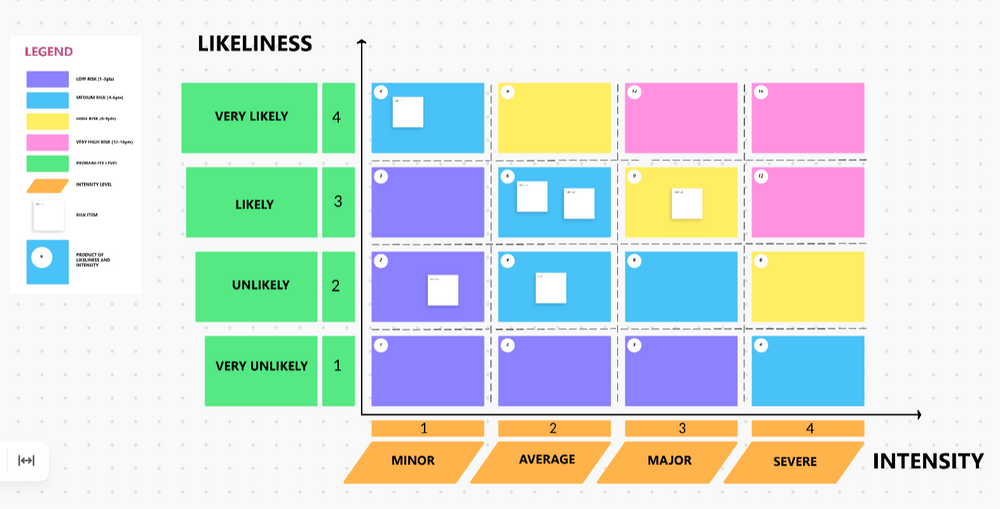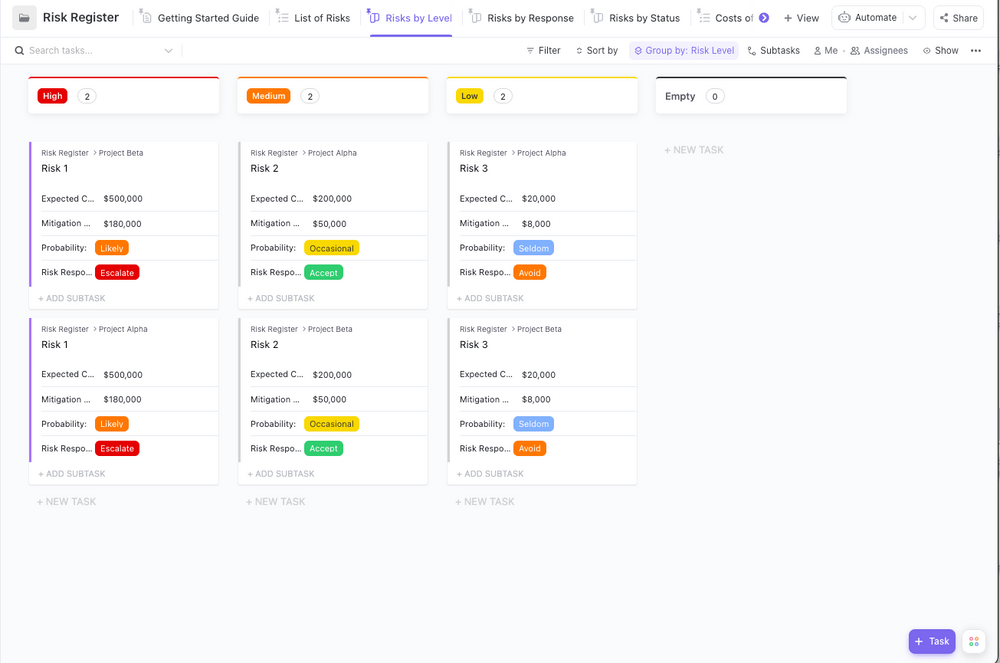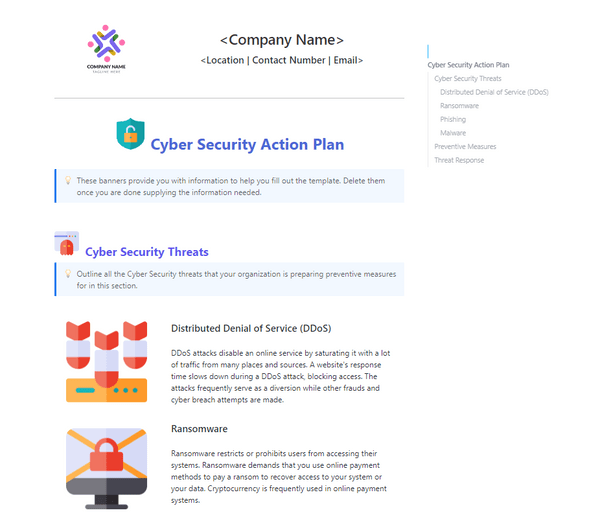Cybersecurity Risk Management: How to Implement a Cybersecurity Risk Framework

Sorry, there were no results found for “”
Sorry, there were no results found for “”
Sorry, there were no results found for “”
Sep 25, 2023
12min read
With the emergence of technology, cybersecurity risks are on the rise, posing a real threat to businesses of all sizes. As a result, organizations have started taking more preventative measures in their approach to cybersecurity to prevent cyber-attacks.
You need to implement a cybersecurity risk management framework to protect your organization. Such a framework will provide a structured approach to identifying, assessing, and managing risks in a systematic process.
Don’t wait until it’s too late. Take proactive steps today to safeguard your business.
This article will illustrate how to assess your cybersecurity posture, create appropriate goals and objectives, select a framework for your risk management process, implement mitigation strategies, and learn how to review the risk process you are following. 🔐
Cybersecurity risk management is a process that helps organizations identify, assess, and prioritize potential risks to their digital assets. This includes data, hardware, software, networks, and other digital components.
It involves implementing policies and procedures to mitigate those risks and protect the organization from cyber-attacks. By proactively managing cybersecurity risks, businesses can prevent or minimize the impact of potential threats.
A cybersecurity risk management framework is a systematic approach that can protect organizations against cyber threats.
It involves recognizing potential risks, evaluating the probability of impact and possible consequences of risks, coming up with security measures to minimize impact, and ongoing monitoring to adjust to emerging risks.
The procedure is thorough and empowers organizations as they take extra measures to secure their information and assets from cyber criminals.
The cybersecurity risk management process is a structured approach to identifying, assessing, and managing risks in an organization . This process helps organizations to make informed decisions about the level of risk that is acceptable for their business operations and create a plan to mitigate those risks.
In the PwC Global Digital Trust Insights Survey, data shows some companies improved cybersecurity in the past year, but only a few actually completely mitigated all cyber risks. Cybersecurity is not only the responsibility of the CISO but also everyone’s business, including the CEO, who has the important role of building and keeping trust through concrete actions.

A structured approach and framework can manage potential risks and enable organizations to do the following:
Preventive measures will assure your customers and stakeholders that you are serious about cybersecurity. As a result, they will feel more secure and will be more likely to continue using your products and services.
Before diving into how to implement a cybersecurity risk management framework, let’s first understand the potential risks that organizations face:
The assessment of your cybersecurity posture is critical in Cybersecurity Risk Management. Below are the steps that can follow:
According to IBM’s Threat Intelligence Index 2023, 27% of cyber attack victims were extortion-related, putting pressure on victims. You’ll need to identify gaps in your risk management strategy to determine any areas that are susceptible to cybersecurity threats.
After evaluating your current security measures, look for gaps that can put your organization at risk for cyber threats. Do you have outdated security solutions, unpatched software, and weak passwords? Do you have untrained employees?
PRO TIP
Use the Risk Assessment Whiteboard Template by ClickUp to help document potential threats on a digital whiteboard and easily collaborate and share it with your team. This template offers a systematic process for identifying, assessing, and controlling hazards and risks to improve the chance of successful project completion.

Clearly defined goals and objectives will allow you to focus on your key priorities and properly allocate your resources.
PRO TIP
Keep your goals organized and track your progress with Goals in ClickUp. Easily create trackable goals, and stay on track to hit your goals with clear timelines, measurable targets, and automatic progress tracking. You can also take advantage of goal-setting templates to help you outline your goals faster.

Choosing your cybersecurity risk management framework is essential for creating a cybersecurity plan. You can select from the four of the most widely recognized framework: NIST, ISO, CIS, and FAIR. Each framework has its advantages and disadvantages; study and compare these risk management frameworks to find the one that fits your requirements.
The NIST Cybersecurity Framework is a voluntary tool provided by the U.S. Department of Commerce to assist businesses of all sizes in managing cybersecurity. Businesses can utilize the framework to address five key areas: identification, protection, detection, response, and recovery.
ISO 27001 is a globally recognized framework for information security management that systematically safeguards and controls confidential data using a risk management approach. This framework includes a set of requirements and guidelines for implementing an information security management system (ISMS) to help organizations keep their information assets secure. The topics covered include risk assessment and management, access control, cryptography, business continuity and compliance.
Organizations often need ISO 27001 certification to show their dedication to information security to customers and partners.
The CIS Controls are guidelines that offer a prioritized approach to managing cybersecurity risks. It includes 20 critical security protocols you can adopt to improve your cybersecurity posture. These controls are designed based on actual cyber threats and offer a comprehensive framework to manage and mitigate cyber risks.
FAIR is a quantitative risk management framework that helps organizations assess and analyze information security risks in financial terms. It provides a systematic approach to risk analysis and helps organizations understand the potential impact and likelihood of different threats. FAIR also helps organizations prioritize their risk management efforts and allocate resources effectively.
You will be more confident in selecting the right framework to customize for your organization when you perform much-needed research and analysis, one that is capable of managing your cybersecurity risks efficiently.
Have your own risk management process to help identify possible risks and predict the likelihood of them taking place. It will also give you a forecast of how much damage it would cause.
Devise your implementing strategies to reduce and control risks, and continuously monitor for effectiveness. Through this, organizations can proactively minimize cyber-attacks.
PRO TIP
Manage your projects and avoid risks using this Risk Register Template by ClickUp. This template comes with pre-built ClickUp views, Custom Fields, and custom statuses to help easily track any potential risks and employ effective preventive measures.

Start managing the cybersecurity risk in your organization, and begin by implementing mitigation strategies. You can start doing this once you have identified and assessed all potential risks.
As you implement new security measures, you will include software installation, network segmentation, access controls, intrusion detection systems, and other controls to help mitigate cyber-attacks.
Keep yourself up-to-date with our ever-changing digital landscape. Periodically check your existing security measures and set aside some budget for them. Allocate a budget for implementing software updates and patches and upgrading hardware to address vulnerabilities, improve access control, and strengthen passwords and encryption protocols.
Lay out your procedures for detecting, assessing the severity, and reporting incidents. Every organization needs to have specific people assigned to the response plan. Each member should have a specific role assigned to communicate with your customers and stakeholders in the event of an incident taking place.
PRO TIP
Data is typically the most valuable asset for most organizations. It’s key to generating revenue, making data protection crucial to their success as a whole. This is why creating a viable cybersecurity implementation plan is important. Use the Cybersecurity Action Plan Template by ClickUp to give your team an organized and detailed outline for your action plans.

Monitoring the effectiveness of cybersecurity measures is crucial to ensure they offer sufficient protection against emerging threats, and reviewing the cybersecurity strategy and incident response plan can help identify what areas require updates.
Activities such as vulnerability assessments, penetration testing, security logs monitoring, incident response report analysis, and training for employee advocacy on security awareness are ways to achieve this.
Evaluating mitigation strategies will be an ongoing process, as it is inevitable for new threats and vulnerabilities to take place. Hence, organizations must remain proactive and always prepared to respond to potential incidents.
Once an evaluation is conducted and any security gaps are identified, updating the security framework is critical. The organization may need to modify or replace the current framework with a more suitable one. Any modifications made to the infrastructure, applications, or business processes should be assessed for potential cybersecurity risks and integrated into the existing framework. When the cybersecurity framework is consistently updated and improved, organizations can guarantee they are adequately prepared against cyber threats.
PRO TIP
Stay on top of your risk management process and plan, manage, and track your cybersecurity process in one place with ClickUp, an all-in-one and secure project management tool. You’ll also get access to a library of templates, including the IT Incident Report Template by ClickUp. Use this template to help you record incident reports and save reliable records of all past incidents associated with their environment, which can be used to assess current security posture and plan for future threats accordingly.

By implementing a risk management framework, all sensitive data and information of your business remain secure from cyber threats. You can also easily identify potential security risks, prioritize your actions based on their impact, and, most importantly, take measures to mitigate them.
Tools like ClickUp, a very powerful and secure project management tool, can help manage your organization’s protocols and projects more efficiently. ClickUp offers a wide range of security features like data encryption, two-factor authentication, and role-based permissions. It secures your work and makes your team members accountable. And to prove that customer security and privacy are ClickUp’s top priority, ClickUp has successfully passed the highest standards of security and achieved ISO 27001, ISO 27017, and ISO 27018 certifications.
In addition to ClickUp, partnering with UpGuard, a cybersecurity company will provide you with an extra layer of security. UpGuard’s platform provides a range of cybersecurity solutions, like vendor risk management, data leak detection, and security ratings. It lets you manage your security risks and ensure you are compliant with industry regulations.
Overall, if you want to protect your business from online attacks, tools like ClickUp and UpGuard will be useful. By taking measures to protect your organization, you can ensure its longevity and growth.

Marites Hervas is an experienced professional in the SEO industry with over a decade of experience. She began her career as a content writer before transitioning to a full-time administrative assistant. In recent years, she has focused on developing her skills in outreach marketing and staying current with the latest SEO trends. In 2021, she joined UpGuard as a Growth Marketing Specialist, bringing her extensive knowledge and expertise to the team.
© 2026 ClickUp